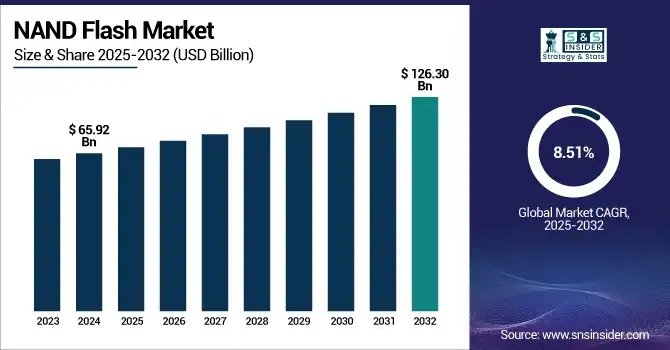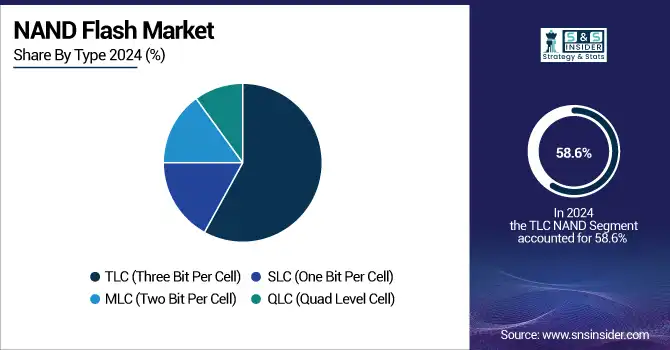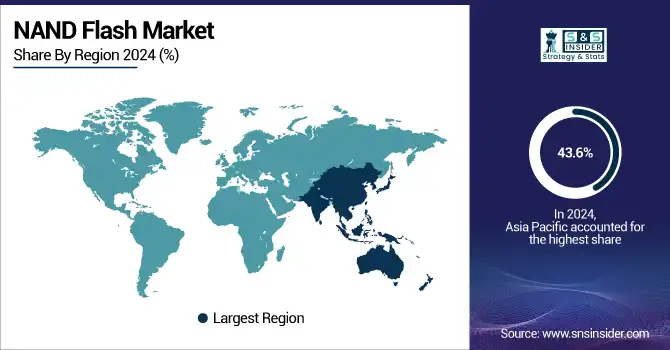NAND Flash Market Size & Growth Trends:
The NAND Flash Market size was valued at USD 65.92 billion in 2024 and is expected to reach USD 126.30 billion by 2032, growing at a CAGR of 8.51% over the forecast period 2025-2032.

To Get more information on NAND Flash Market - Request Free Sample Report
The NAND Flash Market growth in demand for high-performance storage from smartphones, data centers, and solid-state drives (SSDs) The growing demand for smart and intelligent memory to meet the requirement of rapid expansion of AI, 5G and IoT applications is leading to faster, denser and low power consuming memory solutions. Moving to 3D NAND with more stack layers increases density and reduces cost per bit, which is able to serve various use cases. Moreover, rising uptake in automotive electronics, edge computing, and enterprise storage systems is also driving market growth. Sustained market growth is driven by constantly innovating fabrication and packaging as well as continuous demand for reliable, secure, and compact storage.
-
Global NAND flash shipments surpassed 400 billion GB in 2024, with about 85% being 3D-stacked NAND; average smartphone NAND density reached 256 GB, with premium models exceeding 512 GB.
NAND Flash Market Size and Forecast
-
NAND Flash Market Size in 2024: USD 65.92 Billion
-
NAND Flash Market Size by 2032: USD 126.30 Billion
-
CAGR: 8.51% from 2025 to 2032
-
Base Year: 2024
-
Forecast Period: 2025–2032
-
Historical Data: 2021–2023
NAND Flash Market Trends
-
Rising demand for smartphones, tablets, and other consumer electronics is fueling the growth of the NAND Flash market.
-
Expanding applications in data centers and cloud computing are driving high-capacity NAND adoption.
-
Increasing integration of NAND in automotive systems, IoT devices, and industrial applications is accelerating market expansion.
-
Shift toward 3D NAND technology is enhancing storage density, performance, and cost efficiency.
-
Growing use of solid-state drives (SSDs) over hard disk drives (HDDs) is significantly boosting NAND consumption.
-
Continuous advancements in memory architecture and fabrication processes are improving product reliability and scalability.
-
Strategic partnerships and investments by semiconductor manufacturers are strengthening market competition and innovation.
The U.S. NAND Flash Market size is estimated to be valued at USD 65.92 billion in 2024 and is projected to grow at a CAGR of 5.10%, reaching USD 126.30 billion by 2032. NAND flash market in the United States is growing, due to high demand from data centers, cloud computing, artificial intelligence (AI) infrastructure, as well as increased demand for high-performance solid-state drives (SSDs), as well as rapid 5G and Internet of Things (IoT) adoption in both smartphones and edge devices together with the ongoing government-backed investments in fabrication strengthening domestic supplies.
NAND Flash Market Growth Drivers:
-
Rising Data Demand Fuels NAND Flash Growth Through AI 5G IoT and Advanced Storage Technologies
The growth in the global NAND flash market trends is primarily driven by the continuous explosion of data that is generated and consumed, with the increasing number of smart phones, laptops and connected devices now greatly contributing to the data. The demand for NAND is being greatly driven by an increasing dependence on data center and enterprise systems high-performance SSDs, including those for AI, machine learning, 5G infrastructure and IoT applications. Moreover, new technology like 3D NAND and QLC architectures are driving increased storage density, read/write performance, and lower power consumption to keep up with the demands of consumers and enterprises alike.
-
In 2024, global smartphone shipments are expected to reach 1.186 billion units, growing ~4% YoY, with devices increasingly embedding high-capacity 3D NAND
NAND Flash Market Restraints:
-
High Layer 3D NAND Faces Technical Hurdles and Talent Shortage Slowing Innovation and Manufacturing Progress
The growing complexities for manufacturing of advanced nodes & high-layer 3D NAND architectures is one of the key restraints to the NAND flash market. However, when more than 200+ layers are deployed, issues such as interconnect reliability, cell-to-cell interference and yield loss become more critical. It is technically challenging since maintaining consistent performance and endurance across these densely packed layers requires avoiding data retention problems. Moreover, the global shortage of semiconductor engineers and technicians leads to longer development cycles and restricts innovation scalability.
NAND Flash Market Opportunities:
-
NAND Flash Gains Momentum with Edge AI Autonomous Systems and Global Push for Semiconductor Independence
The biggest growth opportunity is the integration of NAND flash into self-driving vehicles, smart factory solutions, and edge computing systems. NAND is well-placed to provide the fast, reliability, and low-latency memory solutions these applications demand. Additionally, the efforts driven by governmental initiatives towards semiconductor self-sufficiency in regions including the U.S., Europe and India presents a huge opportunity for creating capacity, innovations in R&D, and strategic long term growth.
-
Texas Instruments is committing USD 60 billion for seven fabs in Texas and Utah, creating 60,000+ jobs to supply chips for vehicles, data centers, and smartphones.
NAND Flash Market Challenges:
-
Geopolitics and Supply Chain Risks Challenge NAND Market Stability and Hinder Adoption of Emerging Applications
Market stability continues to be disrupted by supply chain vulnerabilities as evidenced by geopolitical tensions, natural catastrophes and export restrictions. Reliance on a small number of suppliers for critical equipment and feedstock creates serious disruption risk. Also, they raise IP protection and data security issues, especially for more compact and faster memory modules. Moreover, the trend of backward compatibility and standardization across different NAND types may slow down the broader adoption of new, diverse applications.
NAND Flash Market Segmentation Analysis:
By Type, TLC NAND dominates the NAND Flash Market, QLC NAND is the fastest-growing segment.
In 2024, TLC NAND dominated the market with the widest share a record of 58.6%, as the flash inspector is the best compromise between price, performance and endurance. Even today, it remains the most popular option in diverse consumer and enterprise applications such as smartphones, laptops and data center SSDs. Looking for higher write endurance than QLC and better storage density than MLC, TLC provides a good combination of reliability and efficiency as a high-capacity storage solution with stable performance. TLC continues to dominate NAND flash thanks to its availability and proven technology.
Over the period of 2025–2032, QLC NAND is shaped to have the highest CAGR because of the necessary need for storage with massive capacity at low cost. Storing four bits per cell with QLC multiplies the data density and lowers the cost per bit. Already improving endurance and reliability, QLC is becoming popular for data-intensive workloads and applications like AI workloads, edge devices, and cold storage in hyperscale data centers.

By Structure, 2-D NAND is the leading segment and expected to grow fastest.
2-D structure is the leading segment and is anticipated to grow at the highest CAGR between 2025 and 2032. While 3D NAND may increasingly hard to see, 2-D NAND still becomes very, very important in smaller amount of applications like embedded systems, USB drive, industrial and stick electronics. It is designed for low-cost devices that need moderate performance, but high reliability because of its simple architecture, low manufacturing complexity, and low cost. 2-D NAND has been kept afloat as the market remains reliant on mature nodes while the performance is stable. Additionally, advances in controller technology and integration with existing systems are broadening its applicability, particularly throughout emerging markets and with memory applications focused on cost-sensitive, long-lasting memory needs.
By Application, Smartphones lead the NAND Flash Market, SSDs are the fastest-growing application segment.
In 2024, smartphones accounted for 38.0% of the total NAND flash market due to increased demand for high performance and large capacity storage in high end mobile devices. These include features such as 5G, AI-enabled applications, high-resolution cameras, and enhanced multimedia functionality, all of which have dramatically heightened the storage needs in smartphones. An increasing volume of data intake from mobile applications mixed with growing amounts of user-generated content puts pressure on manufacturers to adopt higher-density NAND formats, specifically TLC and UFS-based modules which help smooth operation and user experience.
The solid-state drive (SSD) segment is projected to experience the highest CAGR from 2025 to 2032, owing to increasing needs from data centers, cloud services, and enterprise IT infrastructure. NAND flash takes off now that we added more spark to booting from SSDs, the power of high-performance computing and AI: Samsung Where before we relied on HDDs and their slower performance, higher latency and greater power needs, the NAND flash memory market is hitting peak adoption levels now edging into the decades in high-performance computing, in addition to AI and other emerging workloads.
NAND Flash Market Regional Analysis
Asia Pacific NAND Flash Market Insights
In 2024, Asia Pacific held the largest share of the market, accounting for 43.6% and is projected to witness the fastest CAGR of 9.03% from 2025 to 2032. The growth can be attributed to the presence of large semiconductor manufacturing centers, strong electronics production, and a rapidly growing consumer base for smartphones, laptops and other connected devices. Solid investments have come into place with cutting volumes, including NAND flash and memory packaging, which both address domestic and export business in the region. Rise in data center, 5G, and power-optimized AI and machine learning application drives demand for high-speed, low-power NAND flash storage. Further, initiatives from governments to strengthen the semiconductor supply chain, establishment of self-dependent technology ecosystems along with R&D investments with the aim of innovation are phasing a key role in advancing the growth across the region. Asia Pacific continues to be one of the nexus for the future of the global NAND flash market with a good manufacturing base as well as a developing digital ecosystem.
The vast electronics manufacturing base of China alongside high demand for smartphones and data centers, as well as a favorable government policy supporting the advancement of semiconductor capabilities, allowed China to dominate the Asia Pacific NAND flash market.
North America NAND Flash Market Insights
The NAND flash market in North America is fueled by continued demand from modern data centers, enterprise storage systems and AI-driven infrastructure. The region is supported by established cloud service providers and the fast transition towards SSDs in the consumer and enterprise segments. Investments in semiconductor fabrication facilities, R\&D, and AI-trained applications are the other factor to fuel growth. The region's emphasis on digital transformation, edge and 5G deployment, will also fuel the demand for faster, dependable and energy-efficient NAND flash memory solutions.
North America NAND flash market share was led by United States owing to established semiconductor ecosystem, presence of major cloud and data center market, R&D ecosystem, and high AI technology adoption.
Europe NAND Flash Market Insights
The NAND flash market in Europe is growing steadily, driven by an increasing demand for use in automotive electronics, industrial automation and smart manufacturing. It is concentrating on ADAS, electric-vehicle, and Industry-4.0 activities three domains that need high-performance and reliable storage. Continued development of semiconductor self-sufficiency, expansion of edge computing and AI applications also bolster the market. Moreover, the regional growth is also supplemented by the greater demand for low latency memory that is secure pertaining to defense and healthcare.
Middle East & Africa and Latin America NAND Flash Market Insights
The growing digitalization, proliferation of mobile devices and increasing data center infrastructure are gradually fostering the growth of the NAND flash market in Latin America and the Middle East & Africa (MEA). In Latin America, the growth e-commerce, online services, and cloud services is generating demand for stable storage. Opportunities are being created in MEA due to MEA-smart city projects, telecom expansion, and government-led digital transformation initiatives. Global technology firms are also taking notice and are trying to establish a local presence as well as data access in both regions.

Get Customized Report as per Your Business Requirement - Enquiry Now
NAND Flash Market Competitive Landscape:
Kioxia
Kioxia, established in 2019 after Toshiba Memory’s rebranding, is a global leader in flash memory and solid-state drives. The company specializes in NAND flash technologies, storage-class memory, and enterprise SSDs, enabling advanced computing and data-intensive applications. Known for pioneering flash innovation, Kioxia continues to develop next-generation storage solutions optimized for AI, cloud, and hyperscale data centers, driving efficiency, performance, and scalability across industries.
-
June 2025: Kioxia revealed plans for a cutting-edge SSD delivering 10 million IOPS using XL-Flash (SLC NAND) designed for AI workloads, with samples expected in H2 2026.
SK hynix
SK hynix, founded in 1983, is one of the world’s leading semiconductor companies, specializing in DRAM and NAND flash memory. Serving a wide range of industries, from mobile to AI and data centers, the company delivers high-performance memory and storage solutions tailored to next-generation computing needs. With continuous innovation in 4D NAND and advanced packaging technologies, SK hynix plays a critical role in enabling high-capacity, efficient, and fast storage systems globally.
-
April 2025: SK hynix announced development of 321-layer 4D NAND powering UFS 4.1 storage, launching in Q1 2026.
Micron Technology
Micron Technology, founded in 1978, is a global leader in memory and storage solutions, offering DRAM, NAND, and NOR flash products. The company empowers industries such as AI, automotive, cloud, and mobile with high-performance, energy-efficient memory solutions. Known for breakthrough innovations in semiconductor manufacturing, Micron continues to push the boundaries of speed and reliability in storage technology, strengthening its position as a critical enabler of the digital economy.
-
July 2024: Micron started mass production of its ninth-generation NAND flash, delivering up to 7,000 MB/s read speeds with improved performance. The new G9 NAND powers the Micron 2650 SSD.
Key Players
NAND Flash Companies are:
- Samsung
- SK hynix
- Kioxia
- Western Digital
- Micron
- Intel
- YMTC
- ADATA
- Kingston
- Corsair
- Winbond Electronics Corporation
- Macronix International Co., Ltd.
- Transcend Information, Inc.
- TeamGroup Inc.
- Seagate Technology Holdings plc
- Solidigm
- Apacer Technology Inc.
- Lexar
- PNY Technologies Inc.
- Greenliant Systems
| Report Attributes | Details |
|---|---|
| Market Size in 2024 | USD 65.92 Billion |
| Market Size by 2032 | USD 126.30 Billion |
| CAGR | CAGR of 8.51% From 2025 to 2032 |
| Base Year | 2024 |
| Forecast Period | 2025-2032 |
| Historical Data | 2021-2023 |
| Report Scope & Coverage | Market Size, Segments Analysis, Competitive Landscape, Regional Analysis, DROC & SWOT Analysis, Forecast Outlook |
| Key Segments | • By Type (SLC (One Bit Per Cell), MLC (Two Bit Per Cell), TLC (Three Bit Per Cell), QLC (Quad Level Cell)) • By Structure (2-D Structure, 3-D Structure) • By Application (Smartphone, SSD, Memory Card, Tablet, Other Applications) |
| Regional Analysis/Coverage | North America (US, Canada, Mexico), Europe (Germany, France, UK, Italy, Spain, Poland, Turkey, Rest of Europe), Asia Pacific (China, India, Japan, South Korea, Singapore, Australia, Taiwan, Rest of Asia Pacific), Middle East & Africa (UAE, Saudi Arabia, Qatar, South Africa, Rest of Middle East & Africa), Latin America (Brazil, Argentina, Rest of Latin America) |
| Company Profiles | Samsung, SK hynix, Kioxia, Western Digital, Micron, Intel, YMTC, ADATA, Kingston, Corsair, Winbond Electronics Corporation, Macronix International Co., Ltd., Transcend Information, Inc., TeamGroup Inc., Seagate Technology Holdings plc, Solidigm, Apacer Technology Inc., Lexar, PNY Technologies Inc., Greenliant Systems |

